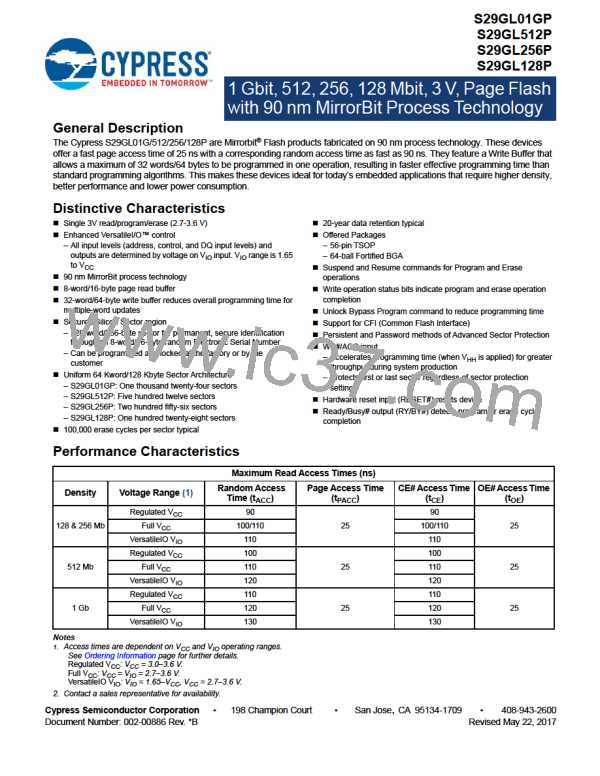S29GL01GP
S29GL512P
S29GL256P
S29GL128P
7.8.2
DQ6: Toggle Bit I
Toggle Bit I on DQ6 indicates whether an Embedded Program or Erase algorithm is in progress or complete, or whether the device
has entered the Erase Suspend mode. Toggle Bit I may be read at any address, and is valid after the rising edge of the final WE#
pulse in the command sequence (prior to the program or erase operation), and during the sector erase time-out.
During an Embedded Program or Erase algorithm operation, successive read cycles to any address that is being programmed or
erased causes DQ6 to toggle. When the operation is complete, DQ6 stops toggling.
After an erase command sequence is written, if all sectors selected for erasing are protected, DQ6 toggles for approximately 100s,
then returns to reading array data. If not all selected sectors are protected, the Embedded Erase algorithm erases the unprotected
sectors, and ignores the selected sectors that are protected.
The system can use DQ6 and DQ2 together to determine whether a sector is actively erasing or is erase-suspended. When the
device is actively erasing (that is, the Embedded Erase algorithm is in progress), DQ6 toggles. When the device enters the Erase
Suspend mode, DQ6 stops toggling. However, the system must also use DQ2 to determine which sectors are erasing or erase-
suspended. Alternatively, the system can use DQ7 (see DQ7: Data# Polling on page 32).
If a program address falls within a protected sector, DQ6 toggles for approximately 1s after the program command sequence is
written, then returns to reading array data.
DQ6 also toggles during the erase-suspend-program mode, and stops toggling once the Embedded Program Algorithm is complete.
See the following for additional information: Figure 7.4, Figure 11.13 on page 60, and Table .
Toggle Bit I on DQ6 requires either OE# or CE# to be de-asserted and reasserted to show the change in state.
7.8.3
DQ2: Toggle Bit II
The “Toggle Bit II” on DQ2, when used with DQ6, indicates whether a particular sector is actively erasing (that is, the Embedded
Erase algorithm is in progress), or whether that sector is erase-suspended. Toggle Bit II is valid after the rising edge of the final WE#
pulse in the command sequence. DQ2 toggles when the system reads at addresses within those sectors that have been selected for
erasure. But DQ2 cannot distinguish whether the sector is actively erasing or is erase-suspended. DQ6, by comparison, indicates
whether the device is actively erasing, or is in Erase Suspend, but cannot distinguish which sectors are selected for erasure. Thus,
both status bits are required for sector and mode information. Refer to Table to compare outputs for DQ2 and DQ6. See
Figure 11.14 on page 60 for additional information.
7.8.4
Reading Toggle Bits DQ6/DQ2
Whenever the system initially begins reading toggle bit status, it must read DQ7–DQ0 at least twice in a row to determine whether a
toggle bit is toggling. Typically, the system would note and store the value of the toggle bit after the first read. After the second read,
the system would compare the new value of the toggle bit with the first. If the toggle bit is not toggling, the device has completed the
program or erases operation. The system can read array data on DQ7–DQ0 on the following read cycle. However, if after the initial
two read cycles, the system determines that the toggle bit is still toggling, the system also should note whether the value of DQ5 is
high (see DQ5: Exceeded Timing Limits on page 35). If it is, the system should then determine again whether the toggle bit is
toggling, since the toggle bit may have stopped toggling just as DQ5 went high. If the toggle bit is no longer toggling, the device has
successfully completed the program or erases operation. If it is still toggling, the device did not complete the operation successfully,
and the system must write the reset command to return to reading array data. The remaining scenario is that the system initially
determines that the toggle bit is toggling and DQ5 has not gone high. The system may continue to monitor the toggle bit and DQ5
through successive read cycles, determining the status as described in the previous paragraph. Alternatively, it may choose to
perform other system tasks. In this case, the system must start at the beginning of the algorithm when it returns to determine the
status of the operation. Refer to Figure 7.4 for more details.
Note
When verifying the status of a write operation (embedded program/erase) of a memory sector, DQ6 and DQ2 toggle between high
and low states in a series of consecutive and contiguous status read cycles. In order for this toggling behavior to be properly
observed, the consecutive status bit reads must not be interleaved with read accesses to other memory sectors. If it is not possible
to temporarily prevent reads to other memory sectors, then it is recommended to use the DQ7 status bit as the alternative method of
determining the active or inactive status of the write operation.
Document Number: 002-00886 Rev. *B
Page 33 of 83

 INFINEON [ Infineon ]
INFINEON [ Infineon ]